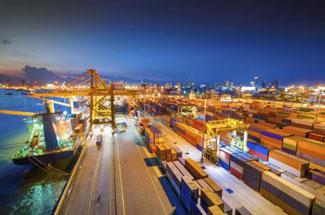Ports Primer for Communities
An Overview of Ports Planning and Operations to Support Community Participation
Check the Community Action Roadmap
The Community Action Roadmap is a companion document that provides a step-by-step process to apply the information in the Ports Primer for building capacity and empowering communities. Check the Community Action Roadmap.
 This Ports Primer for Communities (Ports Primer) area has been designed to provide assistance to near-port
This Ports Primer for Communities (Ports Primer) area has been designed to provide assistance to near-port![]() port The term generally refers to places alongside navigable water (e.g., oceans, rivers, or lakes) with facilities for the loading and unloading of passengers or cargo from ships, ferries, and other commercial vessels. These facilities may be operated by different entities including state or local public port authorities, private terminal operators, and federal agencies. Activities associated with ports include operation of vessels, cargo handling equipment, locomotives, trucks, vehicles, and storage and warehousing facilities related to the transportation of cargo or passengers as well as the development and maintenance of supporting infrastructure (also see inland ports).
port The term generally refers to places alongside navigable water (e.g., oceans, rivers, or lakes) with facilities for the loading and unloading of passengers or cargo from ships, ferries, and other commercial vessels. These facilities may be operated by different entities including state or local public port authorities, private terminal operators, and federal agencies. Activities associated with ports include operation of vessels, cargo handling equipment, locomotives, trucks, vehicles, and storage and warehousing facilities related to the transportation of cargo or passengers as well as the development and maintenance of supporting infrastructure (also see inland ports).![]() portThe harbor area where ships are docked. communities interested in becoming more involved in port
portThe harbor area where ships are docked. communities interested in becoming more involved in port ![]() port The term generally refers to places alongside navigable water (e.g., oceans, rivers, or lakes) with facilities for the loading and unloading of passengers or cargo from ships, ferries, and other commercial vessels. These facilities may be operated by different entities including state or local public port authorities, private terminal operators, and federal agencies. Activities associated with ports include operation of vessels, cargo handling equipment, locomotives, trucks, vehicles, and storage and warehousing facilities related to the transportation of cargo or passengers as well as the development and maintenance of supporting infrastructure (also see inland ports). decisions that may impact local land use, the environment and quality of life. This Ports Primer is intended to help community members participate effectively in the decision-making process by increasing local understanding of:
port The term generally refers to places alongside navigable water (e.g., oceans, rivers, or lakes) with facilities for the loading and unloading of passengers or cargo from ships, ferries, and other commercial vessels. These facilities may be operated by different entities including state or local public port authorities, private terminal operators, and federal agencies. Activities associated with ports include operation of vessels, cargo handling equipment, locomotives, trucks, vehicles, and storage and warehousing facilities related to the transportation of cargo or passengers as well as the development and maintenance of supporting infrastructure (also see inland ports). decisions that may impact local land use, the environment and quality of life. This Ports Primer is intended to help community members participate effectively in the decision-making process by increasing local understanding of:![]()
- The role of ports;
- How ports can impact local land use, economic trends, air quality, and other aspects of the environment and quality of life, and
- Tools and resources that have been successful in other communities.
Formats - Ports Primer for Communities
The Ports Primer is available as an interactive PDF document that can be downloaded (see link below), and through these webpages in HTML format by selecting the icons in the navigation bar at the top of each page to navigate between sections (from 2.0 to 3.0, for example). Additionally, the links at the bottom of each page can be used to move between sub-sections (such as advancing from 2.1 to 2.2). We've made identical Ports Primer content available in both formats to maximize accessibility to as many stakeholders as possible. The PDF document is portable with the ability to access content offline, however, it is not easily printed. Content on the Ports Primer webpages is available online and is more easily printed. There are some slight differences with how information is organized in the webpages, but the content is not altered. Links throughout the Ports Primer in both formats allow users to access additional online resources.











